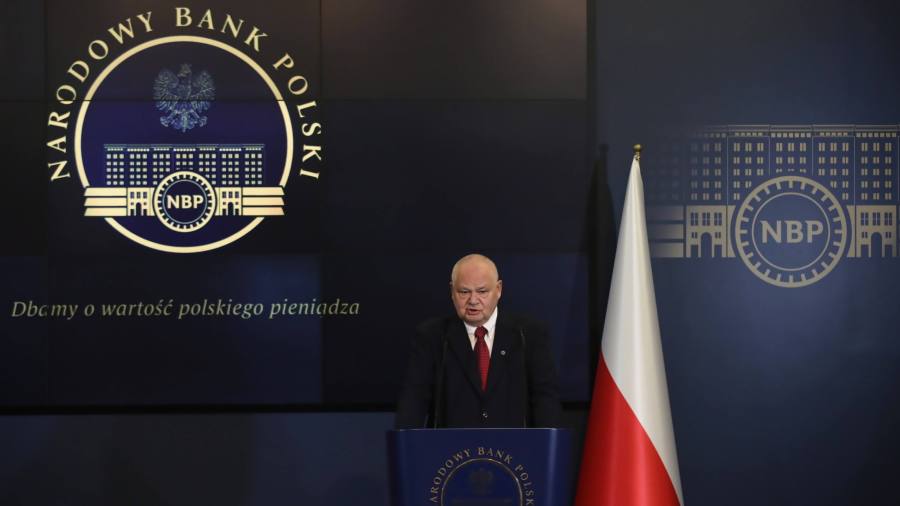Receive free National Bank of Poland updates
We’ll send you a myFT Daily Digest email rounding up the latest National Bank of Poland news every morning.
The Polish zloty has fallen nearly 3 per cent against the euro since the National Bank of Poland’s shock decision to slash interest rates on Wednesday, highlighting the delicate balancing act that central bankers face in trying to shore up growth while inflation remains high.
Rate setters in Poland lowered borrowing costs by 0.75 percentage points to 6 per cent this week, a move three times the size analysts had expected, even though inflation is still running at 10.1 per cent.
A weak currency risks fuelling inflation by raising the price of imports and stimulating demand for exports.
Poland’s central bank governor Adam Glapiński said the decision was based on a “radically changed” economic outlook, with the prospects of a recession in Germany particularly worrisome for Polish exports. He added that he expected inflation to fall to slightly above 8.5 per cent in September and to continue to fall as the economy weakens.
“Poland is connected by the umbilical cord to Germany, which is in a sort of stagflation,” said Gustavo Medeiros, head of research at Ashmore Group.
The German economy has been deteriorating rapidly, with industrial production falling 0.8 per cent in July, more sharply than forecast, figures this week showed. Core inflation in Germany, which strips out volatile food and energy prices, has remained stubbornly above 5 per cent since last October.
“Poland has tried to be more proactive and get ahead of what they believe will be a broader growth slowdown,” said Aaron Grehan, head of hard currency emerging market debt at Aviva Investors.
The move comes at a crucial time for the European Central Bank, which is considering whether or not to raise interest rates as it walks a tightrope of trying to tame rising prices while avoiding exacerbating an economic downturn.
The fall in the zloty may serve as a warning to other central banks as they start to cut rates.
“It’s an extreme move,” said Salman Ahmed, global head of macro at Fidelity International. “The signal they are sending to the market is that they are going to tolerate inflation.”
Some economists argued that Poland’s central bank had been unduly influenced by the goals of the ruling Law and Justice party, which faces a parliamentary election next month.
Currencies in nearby Czech Republic and Hungary were also pulled lower by Poland’s rate decision. However, the moves have been more muted as analysts say these countries are less likely to deliver monetary policy shocks.
The Czech National Bank has kept interest rates at 7 per cent since June last year and is expected to hold rates again at its meeting this month. Headline inflation eased to 8.8 per cent in July.
The National Bank of Hungary has gradually lowered its rate from 18 per cent to 14 per cent since May as inflation has fallen from a peak of more than 25 per cent earlier this year to 16.4 per cent in August.
Ahead of Poland’s rate decision, the strength of the zloty had been seen as instrumental in helping to reduce imported inflation. Grehan said it was unlikely that the central bank would tolerate a rapid depreciation from here, but added that Poland has plenty of foreign exchange reserves should it decide to intervene to support the currency.
Read the full article here



